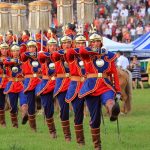
Castile And León Day
Observed annually on April 23rd, Castile and León Day is a holiday that commemorates the date of the Battle of Villalar—a battle in which Castilian rebels were defeated by the royalist forces of King Charles I in 1521. This holiday is exclusively celebrated by the autonomous community of Castile and León.
Celebrations typically begin the night before and continue through the next day. In this autonomous community, this day is a public holiday and coincides not only with the Day of Aragon but also with St. George’s Day. In Spanish, this holiday is known as “Día de Castilla y León.”
The History of Castile and León Day
When Charles V of the Holy Roman Empire became Charles I of the Spanish Empire, it caused some discontent among Spanish citizens who viewed him as only interested in collecting tax money from Spain.
Over the next four years, these resentments would lead to action among many Castilian towns as the local populace began to rise against his rule. The demands from these protesters were simple: they wanted local advisors and a king of Spain who actually lived in Spain.
The Revolt of the Comuneros started with some success—with the cities of Tordesillas, Toledo, and Valladolid coming under the control of the rebels. That would change on April 23, 1521, however, when King Charles defeated them at the Battle of Villalar. This defeat, and the subsequent execution of the rebellion’s leaders, would end the uprising before it could really begin.
Although the battle and the rebellion ended in defeat, there was an upside to the whole situation. King Charles began to take more interest in Spain and spent almost half his reign living in Spain.
The Battle of Villalar was largely forgotten over the years, but renewed interest in it during the 1970s led to large crowds memorializing the date every year. In 1983, Castile and León became an autonomous community and three years later, Castile and León Day would become an official holiday.
Observing Castile and León Day
The night before April 23, people begin camping at the Monolith to the Comuneros in Villalar, and these campers are entertained by various musical groups performing at the monument as well. The next day, there are political speeches, concerts, street theater, and a variety of other activities at the monument, drawing thousands of people.








